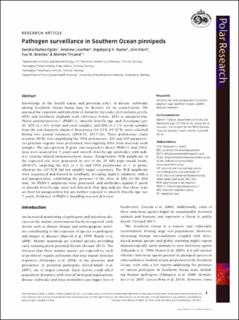| dc.contributor.author | Núñez-Egido, Sandra | |
| dc.contributor.author | Lowther, Andrew | |
| dc.contributor.author | Nymo, Ingebørg H. | |
| dc.contributor.author | Klein, Jörn | |
| dc.contributor.author | Breines, Eva Marie | |
| dc.contributor.author | Tryland, Morten | |
| dc.date.accessioned | 2021-01-12T10:01:18Z | |
| dc.date.available | 2021-01-12T10:01:18Z | |
| dc.date.created | 2021-01-05T15:24:08Z | |
| dc.date.issued | 2020 | |
| dc.identifier.citation | Núñez-Egido, S., Lowther, A., Nymo, I. H., Klein, J., Breines, E. M., & Tryland, M. (2020). Pathogen surveillance in Southern Ocean pinnipeds. Polar Research, 39. | en_US |
| dc.identifier.issn | 0800-0395 | |
| dc.identifier.uri | https://hdl.handle.net/11250/2722500 | |
| dc.description.abstract | Knowledge of the health status and potential effect of disease outbreaks among Southern Ocean fauna may be decisive for its conservation. We assessed the exposure and infection of Antarctic fur seals (Arctocephalus gazella, AFS) and Southern elephant seals (Mirounga leonine, SES) to parapoxvirus, Phocid alphaherpesvirus-1 (PhHV-1), smooth Brucella spp. and Toxoplasma gon-dii. AFS (n = 65) serum and swab samples, and SES (n = 13) serum samples from the sub- Antarctic island of Bouvetøya (54°25’S, 03°22’E) were collected during two austral summers (2014/15, 2017/18). Three polymerase chain reaction (PCR) tests amplifying the DNA polymerase, B2L and GIF parapoxvi-rus genomic regions were performed, investigating DNA from mucosal swab samples. The glycoprotein B gene was targeted to detect PhHV-1 viral DNA. Sera were assayed for T. gondii and smooth Brucella spp. antibodies with indi-rect enzyme-linked immunosorbent assays. Parapoxvirus PCR amplicons of the expected size were generated in two of the 29 AFS pups (nasal swabs, 2014/15), targeting the B2L (n = 2) and DNA polymerase (n = 1) genes, whereas the GIF PCR did not amplify target sequences. The PCR amplicons were sequenced and blasted in GenBank, revealing highest similarity with a seal parapoxvirus, confirming the presence of the virus in AFS for the first time. No PhHV-1 amplicons were generated, and antibodies against T. gondii or smooth Brucella spp. were not detected. Our data indicate that these seals are host for parapoxvirus but are neither exposed to smooth Brucella spp. nor T. gondii. Evidence of PhHV-1 shedding was not detected . | en_US |
| dc.language.iso | eng | en_US |
| dc.rights | Navngivelse-Ikkekommersiell 4.0 Internasjonal | * |
| dc.rights.uri | http://creativecommons.org/licenses/by-nc/4.0/deed.no | * |
| dc.subject | Sel | en_US |
| dc.subject | Pinnipeds | en_US |
| dc.subject | Dyrehelse | en_US |
| dc.subject | Animal health | en_US |
| dc.title | Pathogen surveillance in Southern Ocean pinnipeds | en_US |
| dc.type | Peer reviewed | en_US |
| dc.type | Journal article | en_US |
| dc.description.version | publishedVersion | en_US |
| dc.rights.holder | © 2020, S. Núñez-Egido et al. | en_US |
| dc.source.volume | 39 | en_US |
| dc.source.journal | Polar Research | en_US |
| dc.identifier.doi | https://doi.org/10.33265/polar.v39.3841 | |
| dc.identifier.cristin | 1865797 | |
| cristin.ispublished | true | |
| cristin.fulltext | original | |
| cristin.qualitycode | 1 | |

